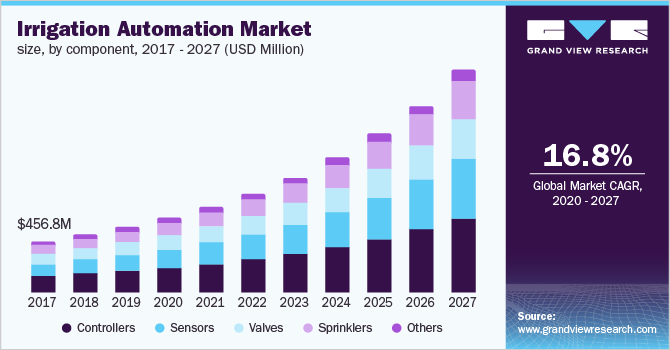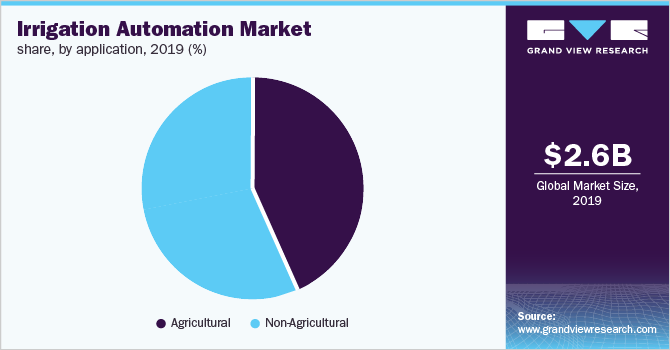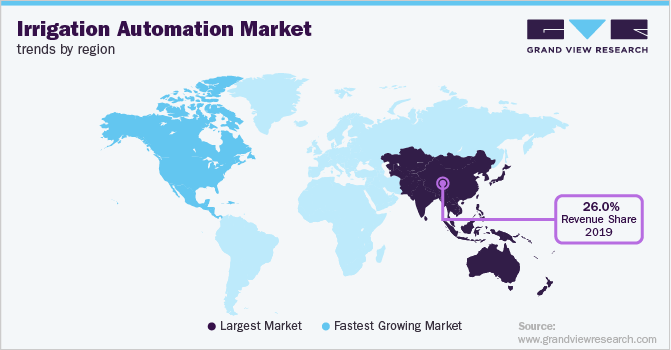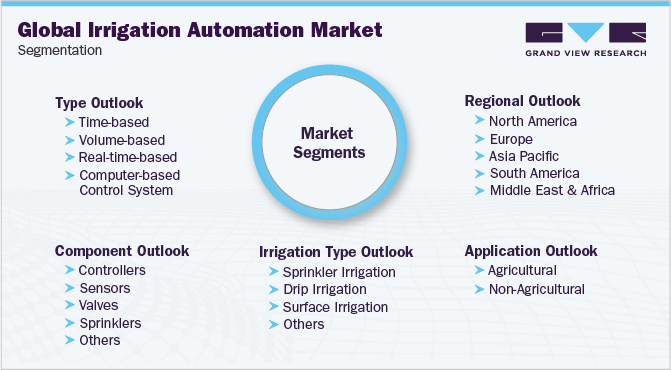- Home
- »
- Next Generation Technologies
- »
-
Irrigation Automation Market Size & Share Report, 2027GVR Report cover
![Irrigation Automation Market Size, Share & Trends Report]()
Irrigation Automation Market Size, Share & Trends Analysis Report By Automation Type, By Component (Controllers, Sensors, Valves, Sprinklers), By Irrigation Type, By Application, And Segment Forecasts, 2020 - 2027
- Report ID: GVR-4-68039-153-5
- Number of Report Pages: 80
- Format: PDF, Horizon Databook
- Historical Range: 2016 - 2018
- Forecast Period: 2020 - 2027
- Industry: Technology
Report Overview
The global irrigation automation market size to be valued at USD 8.96 billion by 2027 and is expected to grow at a compound annual growth rate (CAGR) of 16.8% during the forecast period. The market is expected to witness an incremental surge in demand due to increased water scarcity instances and the shifting trends towards mechanization of agricultural processes across the globe. Increasing water crisis coupled with unpredictable rainfall patterns is excessively hampering the use of conventional agrarian irrigation techniques, thus escalating demand for the use of advanced irrigation techniques for cultivation globally. Irrigation automation systems operate with no or minimum manual intervention besides the surveillance. Also, these systems minimize water wastage, labor expenses, and constant monitoring.

In recent years, the irrigation process has shifted from manual to automatic systems. Feedback-based approaches fused into automated systems have enabled more efficient handling of resources than the traditional irrigation systems. Automatic irrigation requires the integration of hardware components, such as controllers, sprinklers, sensors, valves, and other components, to build an automated system for non-agricultural and agricultural applications. These automatic systems enable the user to modify the irrigation process according to real-time data, time, volume, and computer-based systems to control the watering. Moreover, irrigation automation systems are mostly used in a vast irrigated area, further distributed into small segments termed as irrigation blocks. Then these segments are watered in sequence to match the discharge available from the water source.
Several governments support the installation of irrigation automation systems and take initiatives to promote water conservation globally due to the rising issues of water scarcity. For instance, recently, the Australian government has announced the On-farm Irrigation Efficiency Program (OFIEP) to support individual irrigators to improve the productivity and efficiency of on-farm irrigation water use and management. The program will help irrigators in changing irrigation practices and enhancing irrigation infrastructure to save water. Some of the irrigation practices include installing water metering, automatic outlets or gates, and telemetry systems, among others. Besides, in September 2019, the Government of Western Australia offered a rebate for a weather smart and automated irrigation controller to Perth’s residential customers. The rebate was meant for the programming and purchase of weather automated and smart irrigation products to help them save water.
In the wake of the recent coronavirus (COVID-19) outbreak, irrigation automation manufacturers and sellers have been facing several production issues, including factory shutdowns, non-availability of raw materials, and shortage of resources, among others. Also, the spread of COVID-19 has resulted in disruptions in the supply chain across agriculture ecosystems. The supply of hardware equipment has slowed down and has affected the market players across the irrigation automation value chain. However, due to less human intervention, the remote irrigation operations have been less affected by the pandemic and are expected to witness more robust demand in the forthcoming years.
Irrigation Automation Market Trends
The scarcity of freshwater resources in arid and sparsely urbanized regions and the advancements in greenhouse projects have resulted in the increased dependency on automated irrigation techniques. These included dependency on devices such as controllers and sensors which assist smartly in the spraying of the water and reduce water wastage. In other words, mechanized agricultural activities, and the use of advanced technologies to reduce labor costs, are the major factors driving the demand for the market.
The utilization of smart technologies enable monitoring of weather change, soil condition, water level, and watering schedule in the context of the irrigation system. This is expected to surge demand for the use of advanced irrigation techniques. Therefore, water conservation is an important aspect which increases the use of these techniques and devices in the market by farmers.
Therefore, the need for water conservation is a vital force that increases the use irrigation automation techniques by the farmers. Moreover, there has been a positive push from the government in the form of subsidies on making purchases of drip and sprinkler systems, thereby facilitating the growth of the market in the forecast period.
The increasing use of smart sprinklers which are controllable and respond precisely to the changes in weather conditions are expected to offer profitable opportunities for the market. This owes to the benefits of crop protection from damage, and efficient use for the yield. For instance, the Indian government has implemented centrally sponsored micro irrigation scheme to help smallholder farmers implement agricultural practices. Through this program, the government aims to promote water use efficiency by promoting technological interventions such as drip, and sprinkler irrigation techniques. The significant shift towards the use of drippers and sprinklers for water efficiency is expected to drive business growth. Furthermore, this would enable farmers to focus on water conservation, providing ample opportunities for market growth in the forecast period.
Despite the significant benefits obtained from this market, there are certain aspects that hamper the industry growth. A major limitation is the lack of data management, as the data collected from farms are large which is a difficult task for producers. This is because of the lack of awareness amongst growers regarding making effective decisions with the utilization of data. Furthermore, managing the expense of the automated irrigation techniques in the agriculture system restricts the application thereby, limiting growth in the forecast period.
Automation Type Insights
The time-based automation type segment led the market and accounted for more than 30% of the global revenue in 2019. The high share is primarily attributable to the benefits such as full control of the irrigation process, less labor cost, and less amount of fuel used, among others. The time-based automation system allows the user to control, intervene, and monitor crops at a regular interval of time at different irrigation stages. Therefore, the time-based system is more adapted for the productivity of the harvest.
The real-time based automation type segment is expected to emerge as the fastest-growing segment registering a CAGR of around 18% over the forecast period. The growth is attributable to the growing demand for real-time data gathered using tensiometers and sensors for temperature, rain, and weather. These automated tensiometers are used to calculate the required levels of irrigation in combination with plant evapotranspiration systems. Besides, real-time based automation systems are comparatively more sustainable than time-based systems, as water consumption is lesser. Therefore, the factors mentioned above are anticipated to support segment growth over the forecast period.
Component Insights
The controller segment led the market and accounted for more than 30% of the global revenue share in 2019. The high share of the segment is attributable to the increasing demand for semi-automatic systems, including volume-based and time-based systems, which has led to a rise in demand for controllers in the overall market. Controllers help in providing the required amount of water at the right time according to the desired schedule. Also, controllers direct the entire irrigation process, directed by sensors that help fetch real-time data about the weather, soil, and plant, directly affecting the irrigation process.
The sensors segment is expected to emerge as the fastest-growing segment registering a CAGR of around 18% from 2020 to 2027. Sensors help in gaining real-time soil moisture levels and determining irrigation needs. Sensors improve connectivity and access real-time data via an installed app or a web-based interface to irrigators on their smartphones. Furthermore, with precise soil moisture temperature and measurement predicted solutions through sensors, dripping systems and sprinklers can work simultaneously with automated technology, thereby resulting in higher productivity with a minimal manual workforce. Therefore, the factors mentioned above are anticipated to support the sensor segment growth over the forecast period.
Irrigation Type Insights
The drip irrigation type segment led the market and accounted for more than 35% of the global revenue share in 2019. The segment is anticipated to continue its dominance over the forecast period due to the system’s long life span of almost ten years. This makes it a durable irrigation system with high operating efficiency, resulting in higher consistency in yields. Also, drip irrigation systems eliminate water wastage in terms of field run-off and evaporation. Moreover, factors such as less water consumption ability and lower cost of drip systems are other key factors that drive the segment growth. Therefore, the drip irrigation system is considered the most efficient means of irrigation across the globe except in some Asia Pacific countries, including Japan and China, where high water-demanding crops like rice are sown.
The sprinkler irrigation type segment is projected to exhibit a significant CAGR of more than 16% from 2020 to 2027. Sprinkler helps in moving water over vast distances, thereby improving water consumption efficiency. Also, sprinklers can be incorporated with weather-based intelligent systems, which respond precisely to the real-time weather conditions and are supported by smartphones, offering full control of the irrigation process to the operator. Moreover, the benefits of safety, convenience, and aesthetics provided by the sprinkler irrigation system are the other factors increasing their demand in the overall industry.
Application Insights
The non-agricultural application segment is expected to emerge as the fastest-growing segment registering a CAGR of around 17.5% from 2020 to 2027. The growth is attributable to the upsurge in golf courses, sports grounds, pastures, gardens, residential, and turf and landscapes across the globe. The irrigation automation systems ensure on-time watering with the required amount of water in these non-agricultural applications while decreasing the water bills. Also, automatic irrigation systems in golf courses allow the growers and owners to modify the irrigation based on time or volume and control it remotely.

The agricultural application was the largest segment and accounted for more than 59% of the global revenue in 2019. Agriculture is one of the key occupations in several regions. This factor is anticipated to fuel the growth of the segment. Also, standardized and low production cost makes it affordable for consumers in emerging countries of Latin America and Asia Pacific. The use of automation irrigation saves time and labor. Therefore, this technology is preferred by large farmers and agricultural parks across the globe.
The agricultural segment is divided into three sub-segments, namely, open fields, greenhouses, and others. The greenhouse segment is anticipated to register significant growth over the forecast period, owing to the escalating demand for water-efficient and cost-effective cultivation techniques. The increasing cost of water and electricity, coupled with increasing awareness towards climate change, has encouraged home gardeners and greenhouse owners to implement tools and methods for increasing production efficiency.
Regional Insights
The Asia Pacific region dominated the market with a revenue share of over 26% in 2019. Furthermore, the region is anticipated to continue its dominance over the forecast period due to factors such as the presence of the vast agricultural lands, rapidly changing climatic conditions, strong government support, increased need for reducing wastage of water, and advancement in irrigation instruments. Also, lowering water levels in the region's river basins is forcing people towards sensor-based irrigation systems.

The North America region is projected to exhibit a significant CAGR of around 16.7% from 2020 to 2027. The growth is characterized primarily by the presence of key market participants in the region such as The Toro Company; Valmont Industries Inc.; Rain Birds; Lindsay Corporation; and Nelson Irrigation Corporation. Strict government regulations for reducing water footprint, especially in the U.S., are expected to boost the market growth. The Middle East and Africa region is also anticipated to witness a notable growth as automated irrigation systems have significantly strengthened the green revolution in Israel.
Key Companies & Market Share Insights
The market providers are focusing on new product development and mergers and acquisitions, which aids in strengthening their industry presence. For instance, in July 2020, Lindsay Corporation announced to acquire Net Irrigate, an agriculture Internet of Things (IoT) technology company providing remote monitoring solutions for irrigation consumers. The acquisition aimed at helping growers increase energy and water efficiency and use more advanced and sustainable farming practices while maintaining and operating irrigation systems.
Some prominent players in the irrigation automation market include:
-
The Toro Company
-
Hunter Industries
-
Valmont Industries Inc.
-
Rain Bird Corporation
-
Jain Irrigation Systems
-
Lindsay Corporation
-
Netafim
-
Galcon
-
Rubicon Water
-
Nelson Irrigation
Recent Developments
-
In June 2023, Hunter Industries launched the two new field servers namely Hunter FS-3000 and FS-1000 to enable custom irrigation management in automation platforms. These new field servers allow users to incorporate resource management and irrigation control into custom facilities.
-
In March 2023, Jain Irrigation announced that it completed the transaction with Rivulis to merge its international irrigation business which was earlier intimated in June 2022. The merged entity is expected to be 2nd largest global Irrigation and Climate leader and will explore opportunities in technology innovation, ESG, and hi-tech agricultural inputs.
-
In October 2022, Rubicon Water signed a Memorandum of Understanding (MoU) with the Ministry of Water Resources of the Republic of Uzbekistan to develop a modernized plan for the country’s irrigation landscape. The project involved the installation of remote management software, along with 26 automated control gates.
-
In February 2022, Hunter Golf partnered with POGO® to provide visual insights integrations and new sensors for Hunter Pilot™ Network. This integration will allow customers to utilize powerful scientific insights to achieve maximum irrigation efficiency.
-
In December 2021, Hunter Industries offered a full suite of pressure-regulated Pro-spray bodies, which is the first one to be Water Sense Certified by the U.S. Environmental Protection Agency. This advancement offered by Hunter ensures water conservation of up to 30% more than the non-regulated systems.
Irrigation Automation Market Report Scope
Report Attribute
Details
Market size value in 2020
USD 3.02 billion
Revenue forecast in 2027
USD 8.96 billion
Growth Rate
CAGR of 16.8% from 2020 to 2027
Base year for estimation
2019
Historical data
2016 - 2019
Forecast period
2020 - 2027
Quantitative units
Revenue in USD million and CAGR from 2020 to 2027
Report coverage
Revenue forecast, company ranking, competitive landscape, growth factors, and trends
Segments Covered
Automation type, components, irrigation type, application, region
Regional scope
North America; Europe; Asia Pacific; South America, Middle East & Africa
Country scope
U.S.; Canada; Mexico; U.K.; Germany; France; Russia; China; India; Japan; Australia; Brazil; Argentina; South Africa; Saudi Arabia
Key companies profiled
The Toro Company; Valmont Industries Inc.; Rain Birds; Lindsay Corporation; Nelson Irrigation Corporation
Customization scope
Free report customization (equivalent up to 8 analysts working days) with purchase. Addition or alteration to country, regional & segment scope.
Pricing and purchase options
Avail customized purchase options to meet your exact research needs. Explore purchase options
Global Irrigation Automation Market SegmentationThis report forecasts revenue growth at global, regional, and country levels and provides an analysis of the latest industry trends in each of the sub-segments from 2016 to 2027. For this study, Grand View Research has segmented the global irrigation automation market report based on automation type, component, irrigation type, application, and region:

-
Automation Type Outlook (Revenue, USD Million, 2016 - 2027)
-
Time-based
-
Volume-based
-
Real-time-based
-
Computer-based Control System
-
-
Component Outlook (Revenue, USD Million, 2016 - 2027)
-
Controllers
-
Sensors
-
Valves
-
Sprinklers
-
Others
-
-
Irrigation Type Outlook (Revenue, USD Million, 2016 - 2027)
-
Sprinkler Irrigation
-
Drip Irrigation
-
Surface Irrigation
-
Others
-
-
Application Outlook (Revenue, USD Million, 2016 - 2027)
-
Agricultural
-
Open Fields
-
Greenhouses
-
-
Non-Agricultural
-
Golf Courses
-
Residential
-
Sports Grounds
-
Others
-
-
-
Regional Outlook (Revenue, USD Million, 2016 - 2027)
-
North America
-
U.S.
-
Canada
-
Mexico
-
-
Europe
-
U.K.
-
Germany
-
France
-
Russia
-
-
Asia Pacific
-
China
-
India
-
Japan
-
Australia
-
-
South America
-
Brazil
-
Argentina
-
-
Middle East & Africa
-
South Africa
-
Saudi Arabia
-
-
Frequently Asked Questions About This Report
b. The global irrigation automation market size was estimated at USD 2,650.00 million in 2019 and is expected to reach USD 3,023.65 million in 2020.
b. The global irrigation automation market is expected to grow at a compound annual growth rate of 16.8% from 2020 to 2027 to reach USD 8,964.00 million by 2027.
b. Asia Pacific dominated the irrigation automation market with a share of 27.01% in 2019. This is attributable to factors such as the presence of the vast agricultural lands, rapidly changing climatic conditions, strong government support, increased need for reducing wastage of water, and advancement in irrigation instruments.
b. Some key players operating in the irrigation automation market include The Toro Company, Valmont Industries Inc., Rain Birds, Lindsay Corporation, and Nelson Irrigation Corporation, among others.
b. Key factors that are driving the irrigation automation market growth include increased water scarcity instances, shifting trend towards mechanization of agricultural processes, and increasing government support and initiatives to promote water conservation globally.
Share this report with your colleague or friend.
![gvr icn]()
NEED A CUSTOM REPORT?
We can customize every report - free of charge - including purchasing stand-alone sections or country-level reports, as well as offer affordable discounts for start-ups & universities. Contact us now
![Certified Icon]()
We are GDPR and CCPA compliant! Your transaction & personal information is safe and secure. For more details, please read our privacy policy.
We are committed towards customer satisfaction, and quality service.
"The quality of research they have done for us has been excellent."





